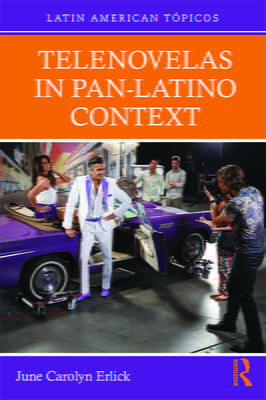A Review of Telenovelas in Pan-Latino Context
(Junk) Food for Thought
When I was running a newspaper bureau in Nicaragua, I once went to look for my housekeeper to ask where we kept something or other. She wasn’t there, but her TV was on. And on the screen were three topless women with fangs, dangling upside down from a ceiling. I turned around to find my housekeeper curiously watching me watching the screen. “What is that?” I asked. “Telenovela,” she replied, as if that explained everything.
I’ve often wondered about the name of that telenovela—the Latin American counterpart to U.S. soap operas—and where it was made. June Carolyn Erlick’s fascinating book Telenovelas In Pan-Latino Context (yes, I am aware of the incompatibility of that title with the word “fascinating;” clearly the marketing department at Routledge needs to be slapped around a bit) did not provide me with the answer. But practically everything else about this weirdly beloved television genre—every gay kiss, narcotrafficker slut, philandering boss, and secretly-exiled-to-the-peasantry oligarch kid, plus the social implications of each one—is included in a book that’s both academic and entertaining.
Erlick, who got to know telenovelas during the years she spent as a newspaper reporter wandering Latin America before joining the staff of Harvard’s Rockefeller Center for Latin American Studies, clearly adores telenovelas and understands both their significance and their triviality. Her book is fully in the spirit of Latin American sociologist Lorenzo Vilches, who once wrote: “It is true that a telenovela is a carrousel of melodramatic clichés. But it is also true that, as Umberto Eco would say, two clichés produce laughter, but a hundred are moving.”
(Time for full disclosure: Erlick and I met in the 1980s while we were both covering the civil war in Nicaragua and have remained friends. But as any number of people who’ve eaten dinner with us over the years will testify, we are fully capable of yelling at one another when she’s wrong about something.)
Which reminds me that I’m not quite right in calling telenovelas soap operas. It’s a comparison that’s often made, and the two forms share some characteristics, particularly their emphasis on hyperemotive romances and melodramatic story lines. But there are also significant differences.
The telenovelas air in prime time with the broadest possible audience, and they have a fixed endpoint: The ugly-duckling heroine turns into a swan (or, in some of the newer narconovelas, a bullet-riddled corpse) and the show is finished, period, usually in six months or less). U.S. soaps, by contrast, go on as long as they draw viewer eyeballs—a mind-boggling 57 years in the case of CBS’ Guiding Light.
Erlick tracks telenovelas back to their gritty origin, on the oors of Cuban cigar factories, where bosses hired lectores—readers—to perch on tall stools, reading newspapers and books to the workers to keep their tedious tasks of cutting and wrapping from driving them mad. By the 1940s, the lectores had spread onto radio, where the voracious appetite for content soon led to the production of scripted dramas with voice actors—the radionovela, which blasted across Latin America faster than any bullet. One São Paulo radio was airing 22 of them a day.
The introduction of television only intensified the process. Because TV sets were imported and heavily taxed, they weren’t widely present in Latin American homes for two or three decades after their introduction. That turned viewing telenovelas into a communal entertainment—and mutual experience—that often took place at a neighborhood bar or a gathering at a friend’s house.
And as scripts, writers and producers jumped back and forth across borders, Erlick writes, telenovelas were “creating a kind of informal globalization long before the term was popularized.”
Globalization, of course, spreads not just goods and services, but ideas as well. Erlick is quite persuasive in her contention that the popularity of telenovelas has combined with their mobility to create a quietly subversive force in socially conservative Latin America.
Taboo topics from birth control to homosexuality, from infidelity to rape, in many countries surfaced publicly for the first time in telenovelas like Mexico’s cheating-husband Senda prohibida (Forbidden Path), or Argentina’s Botineras (Soccer Wives), whose various couplings included a pair of gay soccer players who kissed one another on screen and made it clear they did more intimate stuff off-screen.
Except in a couple of instances, Erlick does not argue that the telenovelas by themselves create significant change; more often, she says, quoting a Chilean study, they have “a multiplying effect and solidify these changes.” But governments keep an eye on them. In 1982, Colombian president Belisario Betancur ordered the producers of Mala hierba (Bad weed), one of the first narconovelas, to give it a new ending—one that was not happy for the drug bosses, lest it make narcotrafficking too inviting.
The less democratic the country, the more elements of a telenovela are potentially subversive. In Nicaragua, under the Marxist Sandinista rule, the broadcast of (an undoubtedly pirated) 1982 Mexican remake of the granddaddy of all telenovelas, El derecho de nacer (The right to be born), became a rallying point for the opposition, which saw it as a celebration of “pretty clothes and pretty landscapes” at a time when the Sandinistas were preaching the creation of a New Man who wouldn’t be distracted by baubles and bangles.
To be fair, Sandinistas liked El derecho too, supposedly because of the discipline and dedication of its doctor-hero and the staff of the hospital in which much of the story unfolded. Though I’ve always suspected its popularity had more to do with the excruciating boredom of the state television network, which specialized in grimly Stakonovite Soviet documentaries, incomprehensibly subtitled Bulgarian sitcoms, and whatever else they could get for free from Havana and Moscow.
But Marxist regimes are surely not the only ones who have profited from the diversionary aspects of telenovelas. When the boss of Mexico’s Televisa network, Emilio Azcarraga, was asked to explain the wild popularity of his Cinderella story Los ricos tambien lloran (The Rich Also Cry), he all but called it the opiate of the masses.
“Mexico is a country of a very screwed over humble class, who are never to stop being screwed over,” he said. “It’s an obligation of television to bring entertainment to those people and take them away from their sad reality and dif cult future.” You don’t need to have quite such a Nietzschean worldview to acknowledge that telenovelas, like all popular art, act in part as a distraction from the drudgery of daily life.
As Erlick notes, telenovela viewers don’t merely watch the shows; they sometimes live them out. In 1969, a Peruvian telenovela called Simplemente María told the story of a poor peasant girl who learns to sew on a machine and turns into first a small businesswoman and ultimately a wildly successful fashion designer. That triggered so many sewing machine sales all over Latin America that Singer presented a gold one to the actress who played María.
The Peruvian sewing machine epidemic seems to have been a spontaneous eruption. But in 1975, Mexico’s Televisa launched a series of telenovelas, written and produced in conjunction with government agencies, that were deliberate attempts at social engineering. One of them, Ven conmigo (Come With Me), set amidst a rural literacy campaign, in which the various characters practiced reading, writing and ripping of bodices with equal enthusiasm, was so successful that when a note at the end of one episode provided an address in Mexico City where literacy materials could be picked up, 25,000 potential students gridlocked the capital streets until well after midnight.
Erlick recounts this in approving language. But that begs a question: At what point does advocacy—particularly state-aided advocacy—turn into propaganda? Even something as innocent sounding as a literacy campaign can easily turn sinister, as citizens of Marxist Cuba or Nicaragua can attest all too readily. I wonder if Erlick would be as sanguine if the Trump administration stuck an anti-abortion story line into The Young and the Restless.
Ultimately, I suspect, the unpredictability of audience reactions will make the telenovelas an unsatisfactory tool for propagandists. Among the most amusing—and, possibly, most chilling—tales related in the book is that of the 2006 Colombian narconovela Sin tetas, no hay paraiso (Without tits, there’s no heaven). Its protagonist is a young woman who becomes a hooker in order to realize her dream, surgically enhanced breasts. From there it’s on to narcotrafficking, orgiastic violence and eventually killing. It shouldn’t require a spoiler alert here to reveal that the eventual conclusion of Sin tetas would meet with Belisario Betancur’s approval.
The popular reaction, however, would not. The moral that many South American women drew from the show was that big breasts are better. Breast-enhancement surgery became a popular gift for teenagers for their quinceañeras, 15th- birthday coming out parties. In Argentina, nightclubs drew big crowds with the raffle of implants. A (female) legislator in Venezuela proposed a program of state aid for underprivileged girls who wanted bigger breasts. Telenovelas almost always have happy endings, but it’s not always clear for whom.
Winter 2018, Volume XVII, Number 2
Glenn Garvin spent decades covering Latin America as a newspaper correspondent, and another dozen as the Miami Herald’s television critic.
Related Articles
A Review of Default: The Landmark Court Battle over Argentina’s $100 Billion Debt Restructuring
In February 2019, I found myself serving as the special attorney general for the then newly recognized interim government of Venezuela, tasked with addressing more than 50 claims before the U.S. courts stemming from the $140 billion debt inherited from Hugo Chávez and Nicolás Maduro.
A Review of Until I Find You: Disappeared Children and Coercive Adoptions in Guatemala
A student in my “Introduction to Cultural Anthropology” course at the University of Delaware approached me several weeks ago, after hearing about my long-term research in Guatemalan communities, to tell me that they were born there, in Guatemala.
A Review of San Fernando: Última Parada, Viaje al crimen autorizado en Tamaulipas
One of Mexico’s best investigative journalists, Marcela Turati, takes readers to terrorized and traumatized San Fernando, a town known for dozens of mass graves, and exposes the depths of criminal brutality and official corruption that hid the bodies and the truth for years.





